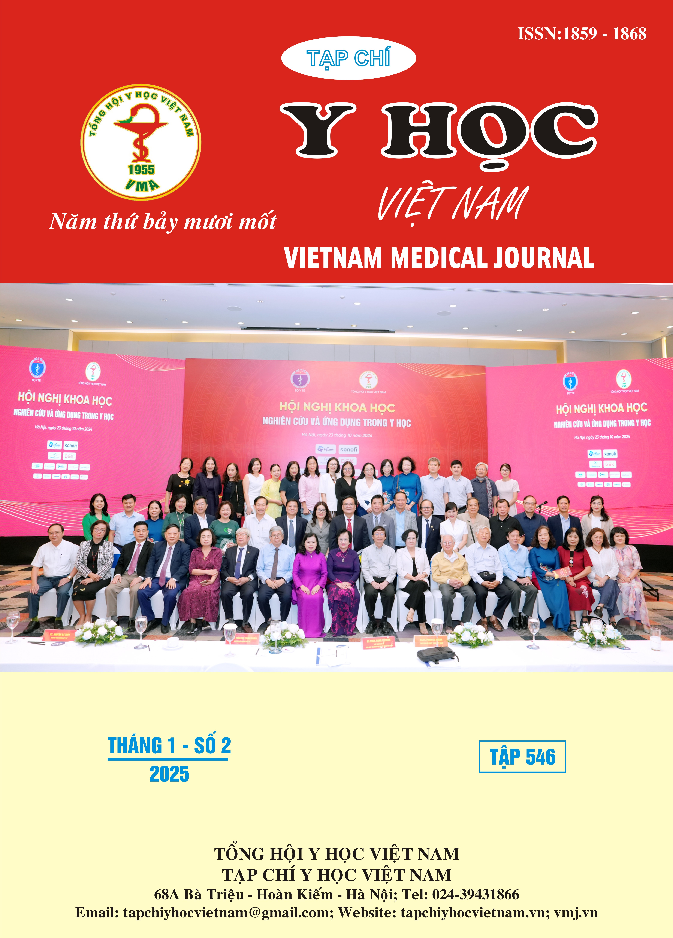TREATMENT OUTCOMES OF ENDOMETRIAL CANCER STAGES I AND II AT PATIENTS UNDER 40 YEARS OLD AT NATIONAL CANCER HOSPITAL
Main Article Content
Abstract
Objective: This study aims to evaluate the clinical and paraclinical characteristics and assess the treatment outcomes of patients with endometrial cancer stages I and II who are under 40 years old at Viet Nam National Cancer Hospital. Subjects and Methods: A retrospective descriptive study was conducted involving 51 patients diagnosed with endometrial cancer at FIGO stages I and II, treated at Viet Nam National Cancer Hospital from January 2017 to December 2023. Results: The average age of the patients was 35.29 ± 4.30 years, with 45.1% having a history related to infertility treatment,33.3% of the patients were diagnosed with polycystic ovary syndrome, and the obesity prevalence was 25.5%. Endometrial adenocarcinoma was the predominant histological type, accounting for 98.04%. The majority of patients were classified as FIGO stage IA (70.6%), followed by stage IB (11.8%) and stage II (17.6%). Postoperatively, 66.7% of patients were discharged for regular follow-up, 25.5% required adjuvant radiotherapy, and 7.8% underwent chemoradiotherapy. The rate of ovarian preservation was 33.3%. The mean overall survival (OS) time was 84.2 ± 3.1 months, and the mean disease-free survival (DFS) time was 82.3 ± 3.6 months.The OS rate at 3 years was 94.5%, and at 5 years it was 94.5%; the DFS rate was 95.3% at 3 years and 91.3% at 5 years. Factors Influencing Overall Survival: Histological grade (p < 0.0001), disease stage (p < 0.0001), lymphatic invasion (p = 0.022), and depth of myometrial invasion (p = 0.033) were statistically significant. Ovarian preservation did not significantly impact OS (p = 0.215). Conclusion: Early-stage endometrial cancer in patients under 40 years is frequently associated with infertility, obesity, and polycystic ovary syndrome, and it has a favorable prognosis. Factors such as histological grade, myometrial invasion, lymphatic invasion, and disease stage significantly affect survival outcomes. Ovarian preservation in young women with early-stage endometrial cancer does not influence overall survival.
Article Details
Keywords
endometrial cancer under 40 years, ovarian preservation in endometrial cancer.
References
2. Yordanov A, Kostov S, Kornovski Y, et al. Endometrial carcinoma in patients under 40 years of age: insights from the Bulgarian Cancer Registry. Ginekol Pol. 2023;94(4):275-282. doi:10.5603/GP.a2022.0106
3. Parazzini F, La Vecchia C, Bocciolone L, Franceschi S. The epidemiology of endometrial cancer. Gynecologic Oncology. 1991;41(1):1-16. doi:10.1016/0090-8258(91)90246-2
4. Abdol Manap N, Ng BK, Phon SE, Abdul Karim AK, Lim PS, Fadhil M. Endometrial Cancer in Pre-Menopausal Women and Younger: Risk Factors and Outcome. IJERPH. 2022;19(15): 9059. doi:10.3390/ijerph19159059
5. Haidopoulos D, Simou M, Akrivos N, et al. Risk factors in women 40 years of age and younger with endometrial carcinoma. Acta Obstet Gynecol Scand. 2010;89(10):1326-1330. doi:10.3109/00016349.2010.515666
6. Jain D, Zaiem F, Solomon G, et al. 429 Survival outcomes in young patients with endometrial cancer: insights from a multi-institutional study. Int J Gynecol Cancer. 2024;34 (Suppl 1):A178. doi:10.1136/ijgc-2024-ESGO.335
7. Utilization and Outcomes of Ovarian Conservation in Premenopausal Women With Endometrial Cancer - PubMed. Accessed August 22, 2024. https://pubmed.ncbi.nlm. nih.gov/26646128/


